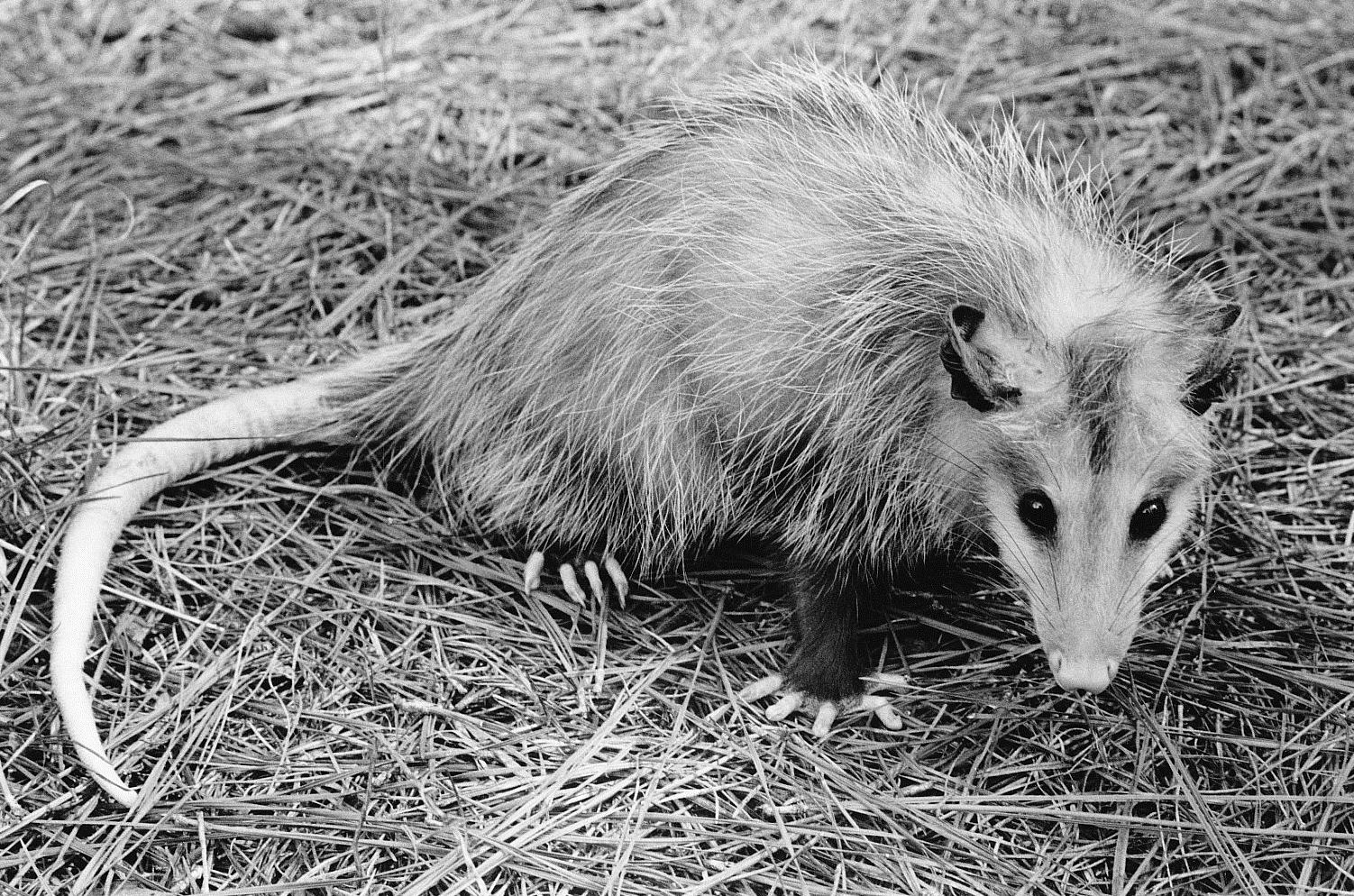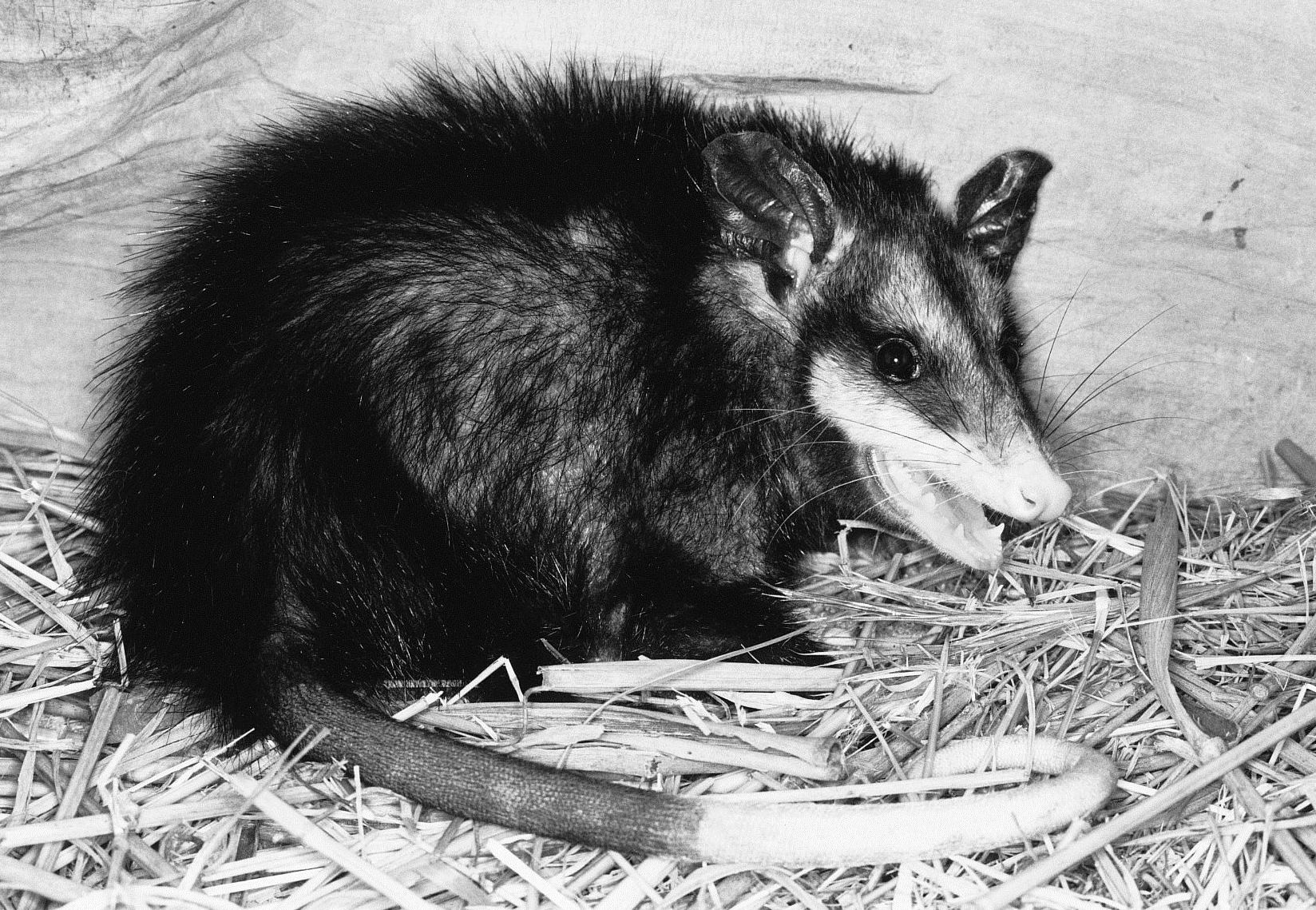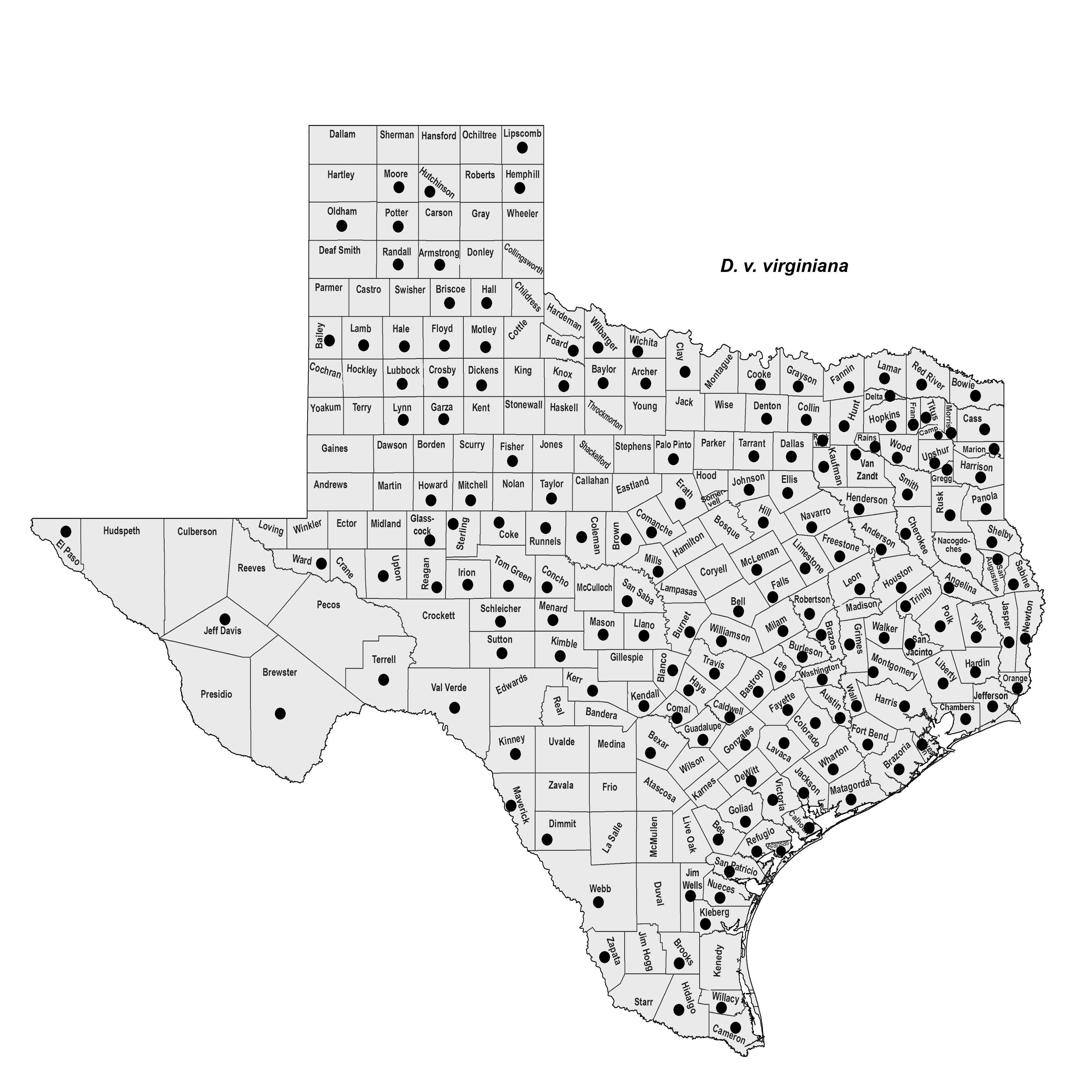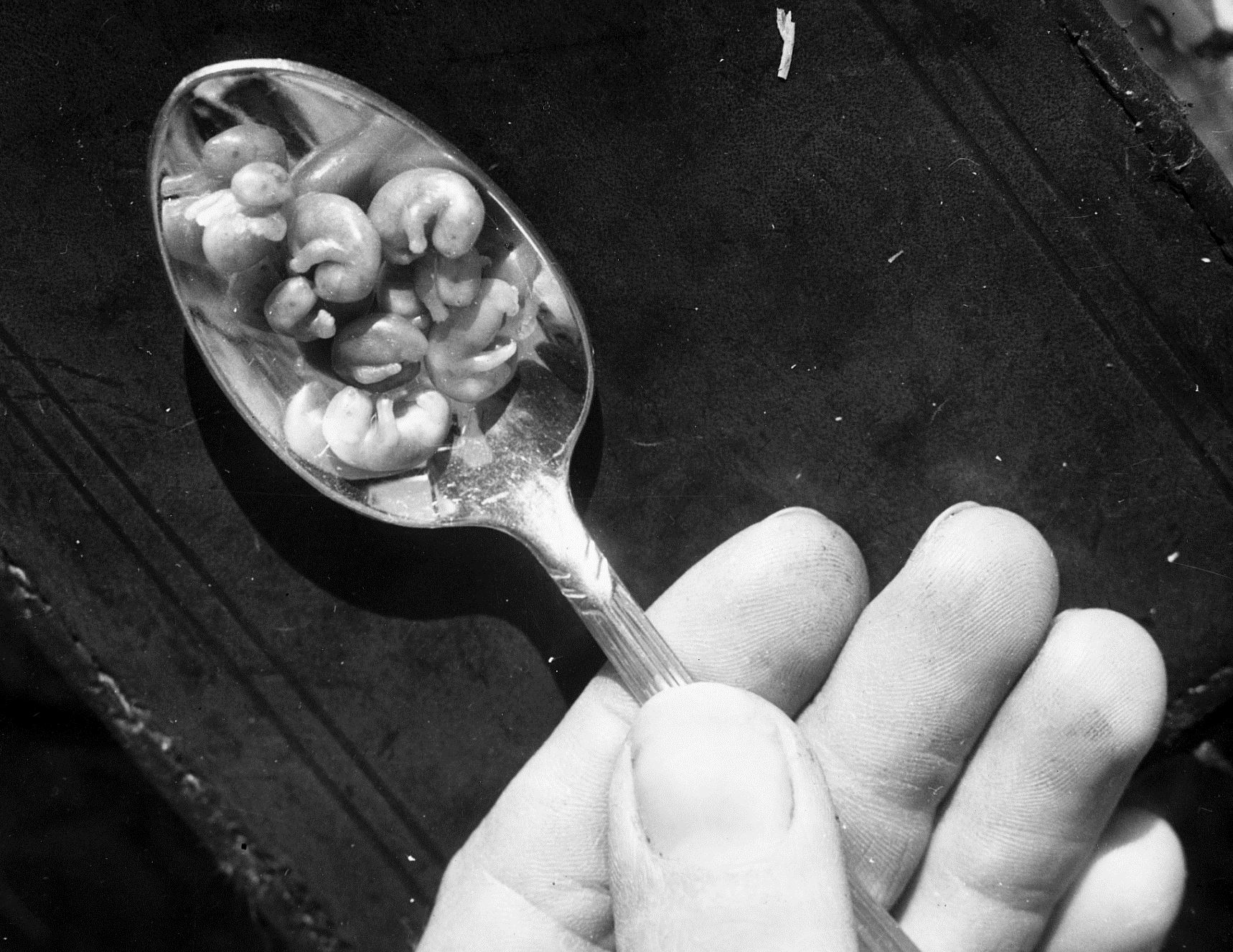VIRGINIA OPOSSUM
Didelphis virginiana Kerr 1792
Order Didelphimorphia : Family Didelphidae
DESCRIPTION. A mammal about the size of a terrier dog, with long, scaly, prehensile tail; short, black, leathery ears; long, slender snout; five toes on each foot, the big toe on hind foot lacking a claw, thumb-like, and opposable; soles naked; pouch for young developed during breeding season on abdomen of female; pelage of long guard hairs and short soft underfur; two color phases, grayish and blackish; basal one-fourth or more of tail black, terminal section whitish; legs and feet blackish, toes often white or whitish. Dental formula: I 5/4, C 1/1, Pm 3/3, M 4/4 × 2 = 50. Averages for external measurements: males, total length, 782 mm; tail, 324 mm; hind foot, 66 mm; females, 710-320-63. Weight, 1.8–4.5 kg; males are usually larger and heavier than females.


DISTRIBUTION. Occurs statewide except for the most xeric areas of the Trans-Pecos.

SUBSPECIES. Didelphis v. virginiana. Some authors continue to apply the trinomial D. v. pigra for populations in the south and southeast, but DJS in his 1983 book on East Texas mammals has shown there is no apparent basis for recognizing two subspecies in the state.
HABITS. Opossums are primarily inhabitants of deciduous woodlands but are often found in prairies, marshes, and farmlands. In the western part of their native range they generally keep to the woody vegetation along streams and rivers, a habit that permits them to penetrate the otherwise treeless grasslands and deserts of West Texas.
Hollow trees and logs are preferred sites, but opossums will den in woodpiles, rock piles, crevices in cliffs, under buildings, in attics, and in underground burrows. Since they are not adept at digging burrows for themselves they make use of those excavated by other mammals.
Movements of opossums monitored in East Texas showed that these animals typically frequent a home range approximately 4.6 ha (11 acres) in size, although the minimum size of home ranges may vary from 0.12 ha to 23.4 ha (0.3–58 acres). Home ranges tend to overlap considerably. In East Texas woodland habitat, the density of opossums is about one opossum every 1.6 ha (4 acres), but in sandy, coastal parts of the state the density is about one opossum every 6 ha (15 acres).
The opossum is more or less solitary and strictly nocturnal, venturing forth to feed shortly after dark. It feeds on a variety of foods, including rats, mice, young rabbits, birds, insects, crustaceans, frogs, fruits, and vegetables. Analyses of six stomachs from winter-trapped opossums in Texas revealed that the following foods (expressed in percentages) had been eaten: insects (grasshoppers, crickets, beetles, true bugs, and ants), 62.8; mammals (cottontails), 19.5; birds (sparrow family), 15.5; reptiles (lizards and snakes), 1.0; mollusks (snails), 1.0; crustaceans (crayfish), 0.2. In June, the food for four opossums was about the same except that fruits and berries were added and birds were lacking. Opossums are expert scavengers and will eat just about anything.
Their mating season extends from January or February to June or July. Females, which are in estrous for about 30 days, breed the first season following birth. The mating period does not last longer than 36 hours and terminates with copulation, which is done in a manner similar to dogs. Young opossums have been observed as early as 24 January and as late as 15 August. Usually two litters are produced, one in February and one in June. The young, 5 to 21 in number, are born after a gestation of 11–12 days, and each weighs about 3 grains (one-fifth of a gram, or one-2,380th of a pound!). Blind, nearly helpless, hardly larger than honeybees, and embryonic in appearance, they crawl unaided into the abdominal pouch of the mother, each attaching itself to a nipple. Shortly after a young one begins to nurse, the nipple swells and completely fills its mouth, thereby firmly attaching it to its mother. It remains attached until it is about 7 weeks of age, at which time it has grown large enough to detach itself. This peculiar adaptation compensates in part for the brief period of uterine development and assumes part of the function performed by the placenta in higher mammals. Since the number of teats is seldom more than 13, young born in excess of that number are doomed to die.

Mortality is high during the first year of life, and population turnover is relatively rapid. Known predators include foxes, coyotes, horned owls, and barred owls. Opossums are commonly seen killed on highways. The normal life span may be as short as 2 years; therefore, opossums have been important model organisms in the research of senescence.
Historically, the Virginia opossum was the third most commonly harvested fur-bearing animal in Texas, but the value of its pelt was low. During the 1999–2000 season, the average value of an opossum pelt was only $0.50. Many trappers do not consider opossums worth skinning. Their fur is used primarily for trim on less expensive coats and hats.
POPULATION STATUS. Common. Opossums occur statewide except in the xeric counties in western High Plains and Trans-Pecos regions. This species is extremely common throughout the riparian and wooded regions of East Texas.
CONSERVATION STATUS. This species is listed by the IUCN as least concern and appears to be increasing in numbers throughout the United States. By dispersing along streams and rivers, it expanded its range throughout the twentieth century, and it adapts well to most human conditions. It does not appear on the federal or state lists of concerned species and does not need any conservation action in Texas.
From The Mammals of Texas, Seventh Edition by David J. Schmidly and Robert D. Bradley, copyright © 1994, 2004, 2016. Courtesy of the University of Texas Press.
Natural Science Research Laboratory
-
Address
Museum of Texas Tech University, 3301 4th street, Lubbock, TX 79409 -
Phone
806.742.2486 -
Email
nsrl.museum@ttu.edu

